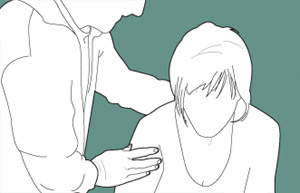
Anxiety is an emotion which is characterized by an unpleasant state of inner turmoil and includes feelings of dread over anticipated events. Anxiety is different from fear in that fear is defined as the emotional response to a real threat, whereas anxiety is the anticipation of a future threat. It is often accompanied by nervous behavior such as pacing back and forth, somatic complaints, and rumination.

Cognitive behavioral therapy (CBT) is a psycho-social intervention that aims to reduce symptoms of various mental health conditions, primarily depression and anxiety disorders. Cognitive behavioral therapy is one of the most effective means of treatment for substance abuse and co-occurring mental health disorders. CBT focuses on challenging and changing cognitive distortions and their associated behaviors to improve emotional regulation and develop personal coping strategies that target solving current problems. Though it was originally designed to treat depression, its uses have been expanded to include many issues and the treatment of many mental health conditions, including anxiety, substance use disorders, marital problems, ADHD, and eating disorders. CBT includes a number of cognitive or behavioral psychotherapies that treat defined psychopathologies using evidence-based techniques and strategies.

Major depressive disorder (MDD), also known as clinical depression, is a mental disorder characterized by at least two weeks of pervasive low mood, low self-esteem, and loss of interest or pleasure in normally enjoyable activities. Introduced by a group of US clinicians in the mid-1970s, the term was adopted by the American Psychiatric Association for this symptom cluster under mood disorders in the 1980 version of the Diagnostic and Statistical Manual of Mental Disorders (DSM-III), and has become widely used since.

Generalized anxiety disorder (GAD) is a mental and behavioral disorder, specifically an anxiety disorder characterized by excessive, uncontrollable and often irrational worry about events or activities. Worry often interferes with daily functioning, and individuals with GAD are often overly concerned about everyday matters such as health, finances, death, family, relationship concerns, or work difficulties. Symptoms may include excessive worry, restlessness, trouble sleeping, exhaustion, irritability, sweating, and trembling.
Functional gastrointestinal disorders (FGID), also known as disorders of gut–brain interaction, include a number of separate idiopathic disorders which affect different parts of the gastrointestinal tract and involve visceral hypersensitivity and motility disturbances.
Dysthymia, also known as persistent depressive disorder (PDD), is a mental and behavioral disorder, specifically a disorder primarily of mood, consisting of similar cognitive and physical problems as major depressive disorder, but with longer-lasting symptoms. The concept was used by Robert Spitzer as a replacement for the term "depressive personality" in the late 1970s.
Biological psychiatry or biopsychiatry is an approach to psychiatry that aims to understand mental disorder in terms of the biological function of the nervous system. It is interdisciplinary in its approach and draws on sciences such as neuroscience, psychopharmacology, biochemistry, genetics, epigenetics and physiology to investigate the biological bases of behavior and psychopathology. Biopsychiatry is the branch of medicine which deals with the study of the biological function of the nervous system in mental disorders.

The diathesis-stress model, also known as the vulnerability–stress model, is a psychological theory that attempts to explain a disorder, or its trajectory, as the result of an interaction between a predispositional vulnerability, the diathesis, and stress caused by life experiences. The term diathesis derives from the Greek term (διάθεσις) for a predisposition or sensibility. A diathesis can take the form of genetic, psychological, biological, or situational factors. A large range of differences exists among individuals' vulnerabilities to the development of a disorder.
Atypical depression is defined in the DSM IV as depression that shares many of the typical symptoms of major depressive disorder or dysthymia but is characterized by improved mood in response to positive events. In contrast to those with atypical depression, people with melancholic depression generally do not experience an improved mood in response to normally pleasurable events. Atypical depression also often features significant weight gain or an increased appetite, hypersomnia, a heavy sensation in the limbs, and interpersonal rejection sensitivity that results in significant social or occupational impairment.

Gene–environment interaction is when two different genotypes respond to environmental variation in different ways. A norm of reaction is a graph that shows the relationship between genes and environmental factors when phenotypic differences are continuous. They can help illustrate GxE interactions. When the norm of reaction is not parallel, as shown in the figure below, there is a gene by environment interaction. This indicates that each genotype responds to environmental variation in a different way. Environmental variation can be physical, chemical, biological, behavior patterns or life events.
Peter McGuffin is a psychiatrist and geneticist from Belfast, Northern Ireland.
Gene–environment correlation is said to occur when exposure to environmental conditions depends on an individual's genotype.

Major depressive disorder, often simply referred to as depression, is a mental disorder characterized by prolonged unhappiness or irritability. It is accompanied by a constellation of somatic and cognitive signs and symptoms such as fatigue, apathy, sleep problems, loss of appetite, loss of engagement, low self-regard/worthlessness, difficulty concentrating or indecisiveness, or recurrent thoughts of death or suicide.

Social anxiety disorder (SAD), also known as social phobia, is an anxiety disorder characterized by sentiments of fear and anxiety in social situations, causing considerable distress and impairing ability to function in at least some aspects of daily life. These fears can be triggered by perceived or actual scrutiny from others. Individuals with social anxiety disorder fear negative evaluations from other people.

Panic disorder is a mental and behavioral disorder, specifically an anxiety disorder characterized by reoccurring unexpected panic attacks. Panic attacks are sudden periods of intense fear that may include palpitations, sweating, shaking, shortness of breath, numbness, or a feeling that something terrible is going to happen. The maximum degree of symptoms occurs within minutes. There may be ongoing worries about having further attacks and avoidance of places where attacks have occurred in the past.
Animal models of depression are research tools used to investigate depression and action of antidepressants as a simulation to investigate the symptomatology and pathophysiology of depressive illness or used to screen novel antidepressants.

Cathryn Lewis is Professor of Genetic Epidemiology and Statistics at King's College London. She is Head of Department at the Social, Genetic and Developmental Psychiatry Centre, Institute of Psychiatry, Psychology and Neuroscience.
In the context of the nature-nurture debate, interactionism is the view that all human behavioral traits develop from the interaction of both "nature" and "nurture", that is, from both genetic and environmental factors. This view further holds that genetic and environmental influences on organismal development are so closely interdependent that they are inseparable from one another. Historically, it has often been confused with the statistical concept of gene-environment interaction. Historically, interactionism has presented a limited view of the manner in which behavioral traits develop, and has simply demonstrated that "nature" and "nurture" are both necessary. Among the first biologists to propose an interactionist theory of development was Daniel Lehrman. Since then, numerous interactionist perspectives have been proposed, and the contradictions between many of these perspectives has led to much controversy in evolutionary psychology and behavioral genetics. Proponents of various forms of interactionist perspectives include Philip Kitcher, who refers to his view as "causal democracy", and Susan Oyama, who describes her perspective as "constructive interactionism". Critics of interactionism include major figures in behavioral genetics such as Arthur Jensen, Robert Plomin, and philosopher Neven Sesardic.
Environmental sensitivity describes the ability of an individual to perceive and process information about their environment. It is a basic trait found in many organisms that enables an individual to adapt to different environmental conditions. Levels of Environmental Sensitivity often vary considerably from individual to individual, with some being more and others less sensitive to the same conditions. Such differences have been observed across many species such as pumpkinseed fish, zebra finches, mice, non-human primates and humans, indicating that there is a biological basis to differences in sensitivity.
Vantage sensitivity is a psychological concept related to environmental sensitivity, initially developed by Michael Pluess and Jay Belsky. It describes individual differences in response to positive experiences and supportive environmental influences. According to vantage sensitivity, people differ considerably in their sensitivity to positive aspects of the environment, with some people benefitting particularly strongly from positive experiences such as parental care, supportive relationships, and psychological interventions, whereas others tend to respond less or not at all.









